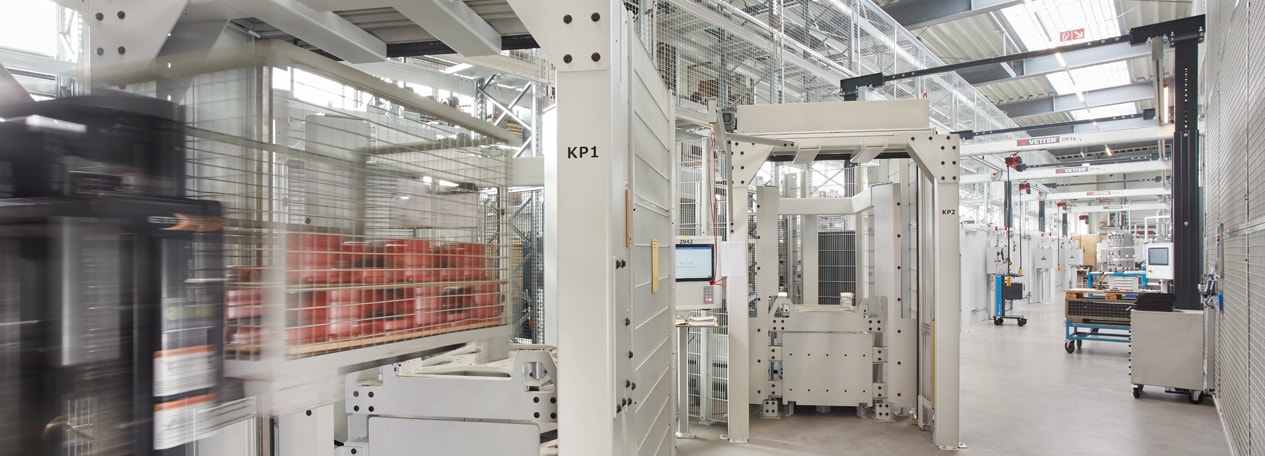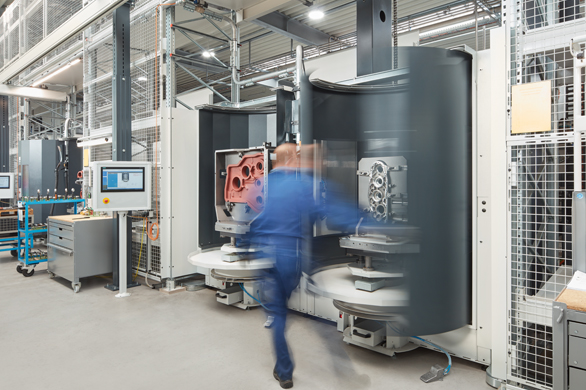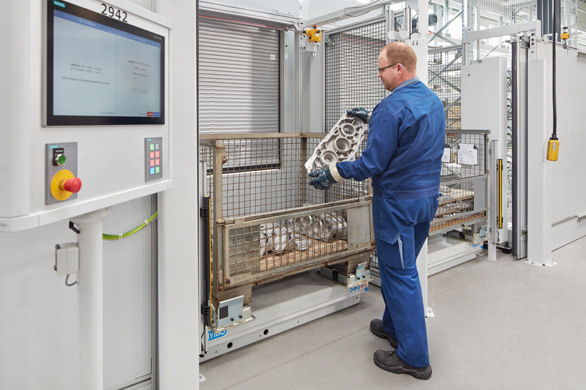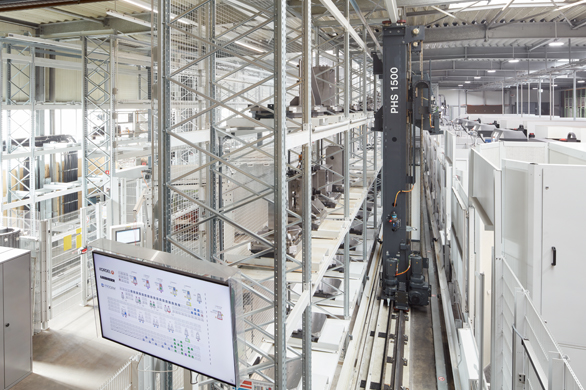You are here
Liebherr Group: Products & Services for Turkey
Other websites for Turkey

How can we ensure maximum manufacturing productivity? What is the best automation system for our wide variety of parts? Which partner can reliably put our plans and requirements into practice? These are the kinds of questions that every manufacturing company aiming to increase its productivity has to ask. Kordel Antriebstechnik GmbH, based in the Westphalian town of Dülmen, found the right solution for its gearbox production with a pallet handling system from Liebherr
Kordel’s product range includes gearboxes for industrial trucks, agricultural machinery (headers in corn choppers and combine harvesters), and for construction machinery such as road cutters and pavers. Kordel is one of the few gearbox suppliers with sufficient vertical integration to cover every step from the blank to the finished gearbox part, including hardening and nitriding, all the way through to assembly. The company produces around 325,000 gearboxes every year.
The basic idea in this case was to replace the daily setup that was required on stand-alone machines with automated processes. Johannes Kordel, the General Manager responsible for technical management at Kordel, has been with the company for 35 years. Together with his team, he took a thorough look around the market before starting this major automation project. In order to successfully plan automation, it is important to know all the facts and weigh the requirements against each other.

Using the time “parallel to machining” has always been the key when it comes to optimum utilization of machine tools. If all the processes that are not directly part of the actual machining take place simultaneously elsewhere and all parts arrive at the next station at the right time, it means the machine is optimally utilized, and expensive downtimes are minimized. In addition to price and quality, timely delivery is the third key aspect that suppliers must guarantee in order to be competitive.
The plans to modernize production with automated systems in Dülmen and the second production site in Jawor, Poland, began four years ago. For new machining centers for drilling and hobbing cast iron and aluminum gear components, an automated material supply system from the warehouse to the machine and back again was created. The two systems, each with two PHS 1500 PRO lines, were the biggest single order to date for Liebherr pallet handling systems.
The project planners first analyzed all the processes and then decided for each step whether it should be automated or carried out manually. “In some ways it’s different with us than at other companies, but at each point we chose the method that seems most suitable,” say Peter Hörsting and Dirk Strotmann, the experts in charge of programming, clamp construction and machining. While the main argument for automation in Dülmen was to minimize setup times, which used to take about a third of the machine time, at the Jawor location the decision was determined by the lack of qualified workers.

Because Kordel produces around 25,000 different parts in-house, the material supply must be adapted to this huge variety. The processes are determined by the batch sizes of typically five to 30 parts per order. This makes the supply of materials a critical aspect; the shuttle that brings the blanks to the machine must not become a bottleneck. “The machining center is the most expensive component; it must always be running and must never have to wait for the connected systems,” says Johannes Kordel, summarizing the most important specification. It quickly became clear that, at the required cycle time, this could not be done with a single system. This was the determining factor for the system to consist of two lines: a material storage system and a production system, each with a storage and retrieval unit. The two systems continually communicate with each other via a shared control system. When the idea for the architecture with two lines was first conceived, it was calculated how many machines could be operated with this type of system. As a result, the pallet handling systems are now designed for up to six machines. There are currently five identical machining centers at both locations.
The lines are laid out in parallel to minimize the distance between the two sides. To maintain a high frequency and short cycle times, smooth processes at all the transfer points are required. On the material side, there are two loading and unloading stations for forklifts and eight for manual removal. When storage and retrieval unit 1 takes a finished housing from the machine to a setup station of the production system, storage and retrieval unit 2 removes a lattice box for finished parts and a lattice box with raw parts from the material storage system. All the required tools have to be stored and kept in stock as well. A small number of very specialized measuring devices are not provided at every processing station, but most of the workpieces will be processed at all the stations. In addition to the six setup stations on the machine side, which are arranged in pairs and operated by a total of three employees, there is a separate station for more complicated items, new clamping fixtures or problem cases so that the employees can continue working undisturbed at the double stations. The machine processes the job and returns the clamping fixture. Each component has its own lifting appliance, which must be provided at the right time. These accessories for specific workpieces are also essential for successful automation.

The system is unique because of the parallel lines of shelving in the material warehouse and the flexible manufacturing system with a shared master control system. In addition to this, Kordel requested that lowering platforms be installed on the removal side of the storage line. The normal height of the storage and retrieval machine is too high for manually removing the lattice boxes. In the high position, the box moves out of the device onto the platform, which then moves down so that the operator can easily remove the component and clamp it on the setup pallet in the processing line. These platforms were also supplied by Liebherr, but are not a standard part of the pallet handling system. Johannes Kordel judges: “We liked the technical design of the mechanical parts as well as the tidy environment. The appearance meets our requirements and those of our customers, who regularly carry out audits at our site.”
We formulated our ideas and a system was developed that is precisely tailored to our situation. That’s not possible with companies who only let you order from their catalogs.
Alongside the technical expertise that Liebherr demonstrated with a gear cutting machine in Kordel’s gearbox manufacturing facility, Liebherr’s communication and flexibility were also deciding factors for the renewed cooperation on the automation project. “The first meeting with all the representatives took place within just 14 days. At that meeting, they were able to answer all our questions. This made us feel confident about the project from the beginning,” says Johannes Kordel, recalling the start of planning. What he liked most of all was that Liebherr listened. “We formulated our ideas and a system was developed that is precisely tailored to our situation. That’s not possible with companies who only let you order from their catalogs.” Once the decision had been made in favor of the PHS 1500 PRO, all the details were discussed and individually resolved on a regular, often daily basis. The various adaptations and the two-line architecture, which was new to Liebherr too, made the project an exciting experience for both sides.
Liebherr’s strength lies in its ability to flexibly implement individual customer requests. For example, Liebherr takes care of the connection to existing production systems and adapts the interfaces. At Kordel, all elements of the new production line communicate via the existing host computer supplied by the Berlin company PROCAM Steuerungstechnik.
Knut Jendrok, Liebherr’s Head of Sales for Pallet Handling Systems says: “The specific issues that Kordel brought into the planning weren’t at all obvious ones. It’s extremely helpful when a customer formulates its requirements so precisely according to the circumstances. This helps us work well together and it becomes a productive cooperation.”

Industries: Gearbox manufacturing for industrial trucks, agricultural machinery, construction machinery
Company size: 950 employees
Founded: 1879 as a forging shop
Headquarters: Dülmen, Germany
Locations: Dülmen-Rödder, Dülmen Dernekamp, Jawor (Poland)
Turnover: Approx. 140 million euro /year
Website: www.kordel.de